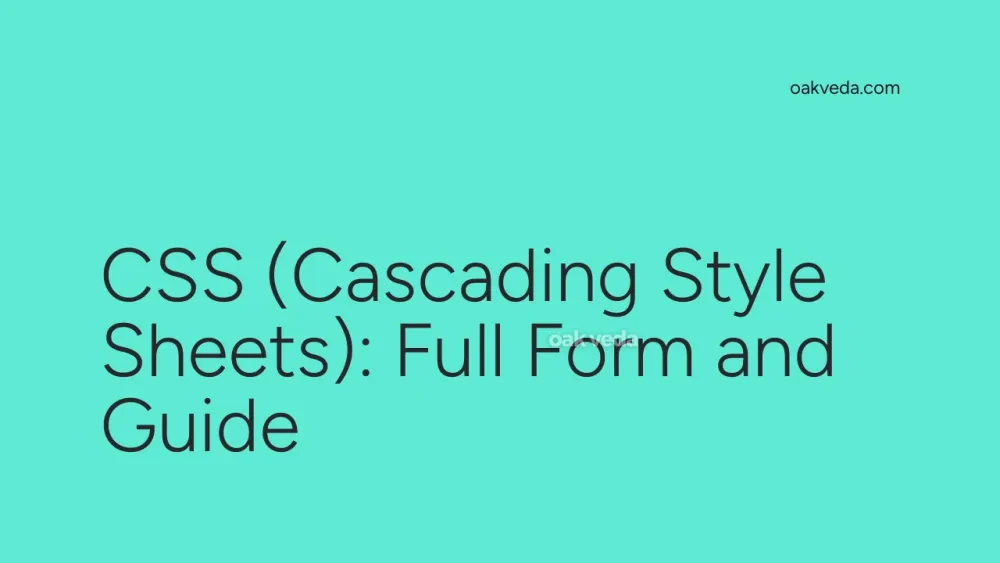
What is the Full Form of CSS?
CSS is the acronym for Cascading Style Sheets. This powerful web technology is essential for modern web design and development, allowing designers and developers to control the visual presentation of web pages.
What is Cascading Style Sheets?
Cascading Style Sheets, commonly known as CSS, is a styling language used to describe the presentation of a document written in HTML or XML. It enables web designers to separate the content of a website from its visual styling, providing greater flexibility and control over the appearance of web pages.
Origin and Development of Cascading Style Sheets
The World Wide Web Consortium (W3C) introduced CSS in 1996 to address the growing need for a more efficient way to style web pages. Before CSS, HTML was used for both structuring content and defining its presentation, which led to complex and difficult-to-maintain code.
Key milestones in CSS development:
- 1996: CSS1 specification released
- 1998: CSS2 specification published
- 2011: CSS3 modules begin rolling out
- Present: Ongoing development of CSS modules and features
How does Cascading Style Sheets work?
CSS works by applying styles to HTML elements through a series of rules. These rules consist of selectors (which identify the elements to be styled) and declarations (which define the styles to be applied). The term "cascading" refers to the way styles are applied in a hierarchical manner, with more specific rules taking precedence over general ones.
Types of CSS
There are three main types of CSS implementation:
-
Inline CSS: Styles are applied directly to individual HTML elements using the
styleattribute. -
Internal CSS: Styles are defined within the
<style>tag in the HTML document's<head>section. -
External CSS: Styles are stored in a separate
.cssfile and linked to the HTML document.
Functions of Cascading Style Sheets
CSS serves several crucial functions in web development:
- Layout control: Positioning elements on the page
- Typography management: Defining font styles, sizes, and colors
- Color and background manipulation: Setting colors and background images
- Responsive design: Creating layouts that adapt to different screen sizes
- Animations and transitions: Adding dynamic effects to web elements
Applications of Cascading Style Sheets
CSS is widely used across various web-related applications:
- Websites: From simple blogs to complex e-commerce platforms
- Web applications: Creating user interfaces for web-based software
- Mobile web design: Optimizing websites for mobile devices
- Email templates: Styling HTML emails for better readability
- Print stylesheets: Formatting web content for print media
Features of Cascading Style Sheets
CSS offers a wide range of features that make it an indispensable tool for web designers:
- Selectors: Targeting specific elements or groups of elements
- Box model: Controlling element dimensions, padding, borders, and margins
- Flexbox and Grid: Advanced layout systems for responsive design
- Media queries: Applying styles based on device characteristics
- Custom properties (CSS variables): Reusable values for consistent styling
- Transforms and transitions: Creating smooth visual effects
- Animations: Defining keyframe-based animations
Benefits of Cascading Style Sheets
Implementing CSS in web projects offers numerous advantages:
- Improved maintainability: Separating content from presentation makes updates easier
- Faster page loading: Reduced file sizes and browser caching of stylesheets
- Consistency across pages: Apply the same styles to multiple pages effortlessly
- Enhanced accessibility: Proper styling can improve readability and usability
- Cross-browser compatibility: CSS helps ensure consistent rendering across different browsers
- Responsive design: Easily adapt layouts for various screen sizes and devices
- Reduced development time: Reusable styles and frameworks streamline the design process
Limitations or Challenges of Cascading Style Sheets
While CSS is powerful, it does have some limitations:
- Browser inconsistencies: Different browsers may interpret CSS rules differently
- Specificity conflicts: Complex stylesheets can lead to unexpected style applications
- Learning curve: Mastering advanced CSS concepts can be challenging for beginners
- Performance issues: Poorly optimized CSS can impact page load times
- Lack of variables (in older versions): CSS3 introduced custom properties to address this
Future Developments in Cascading Style Sheets Technology
CSS continues to evolve, with exciting developments on the horizon:
- CSS Houdini: Giving developers more control over rendering engines
- CSS Grid Level 2: Enhanced layout capabilities
- Container queries: Styling based on parent element size rather than viewport
- Improved color functions: More advanced color manipulation techniques
- Nesting: Native support for nesting selectors, similar to preprocessors
FAQs on CSS Full Form
-
What file extension is used for CSS? CSS files typically use the
.cssextension. -
Can I use multiple stylesheets on a single web page? Yes, you can link multiple CSS files to a single HTML document.
-
What are CSS frameworks? CSS frameworks are pre-written, standardized CSS code that helps streamline web development. Popular examples include Bootstrap, Foundation, and Tailwind CSS.
-
Is CSS case-sensitive? CSS is generally case-insensitive, except for certain parts like element names and attribute selectors.
-
How can I override existing CSS styles? You can override styles by using more specific selectors or the
!importantdeclaration (though the latter should be used sparingly).
In conclusion, Cascading Style Sheets (CSS) is a fundamental technology for modern web design, offering powerful tools for creating visually appealing and responsive websites. As the web continues to evolve, CSS remains at the forefront of innovation in digital design and user experience.
You may be interested in:
- SQL (Structured Query Language): Full Form Explained
- ESA (European Space Agency): Full Form and Overview
- TCP/IP (Transmission Control Protocol/Internet Protocol)
- SAT (Scholastic Assessment Test) Full Form
- ICICI (Full Form): Industrial Credit and Investment Corporation of India
- LLP (Limited Liability Partnership) Full Form

